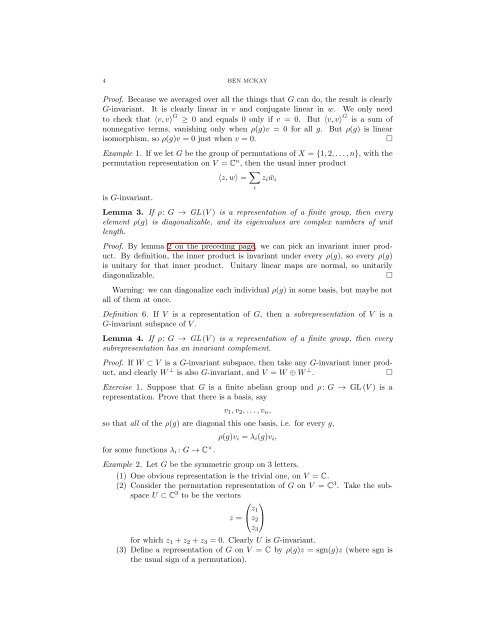NOTES ON REPRESENTATIONS OF FINITE GROUPS Contents 1 ...
NOTES ON REPRESENTATIONS OF FINITE GROUPS Contents 1 ...
NOTES ON REPRESENTATIONS OF FINITE GROUPS Contents 1 ...
Create successful ePaper yourself
Turn your PDF publications into a flip-book with our unique Google optimized e-Paper software.
4 BEN MCKAYProof. Because we averaged over all the things that G can do, the result is clearlyG-invariant. It is clearly linear in v and conjugate linear in w. We only needto check that 〈v, v〉 G ≥ 0 and equals 0 only if v = 0. But 〈v, v〉 G is a sum ofnonnegative terms, vanishing only when ρ(g)v = 0 for all g. But ρ(g) is linearisomorphism, so ρ(g)v = 0 just when v = 0.□Example 1. If we let G be the group of permutations of X = {1, 2, . . . , n}, with thepermutation representation on V = C n , then the usual inner product〈z, w〉 = ∑ iz i ¯w iis G-invariant.Lemma 3. If ρ: G → GL (V ) is a representation of a finite group, then everyelement ρ(g) is diagonalizable, and its eigenvalues are complex numbers of unitlength.Proof. By lemma 2 on the preceding page, we can pick an invariant inner product.By definition, the inner product is invariant under every ρ(g), so every ρ(g)is unitary for that inner product. Unitary linear maps are normal, so unitarilydiagonalizable.□Warning: we can diagonalize each individual ρ(g) in some basis, but maybe notall of them at once.Definition 6. If V is a representation of G, then a subrepresentation of V is aG-invariant subspace of V .Lemma 4. If ρ: G → GL (V ) is a representation of a finite group, then everysubrepresentation has an invariant complement.Proof. If W ⊂ V is a G-invariant subspace, then take any G-invariant inner product,and clearly W ⊥ is also G-invariant, and V = W ⊕ W ⊥ .□Exercise 1. Suppose that G is a finite abelian group and ρ: G → GL (V ) is arepresentation. Prove that there is a basis, sayv 1 , v 2 , . . . , v n ,so that all of the ρ(g) are diagonal this one basis, i.e. for every g,for some functions λ i : G → C × .ρ(g)v i = λ i (g)v i ,Example 2. Let G be the symmetric group on 3 letters.(1) One obvious representation is the trivial one, on V = C.(2) Consider the permutation representation of G on V = C 3 . Take the subspaceU ⊂ C 3 to be the vectors⎛ ⎞z 1z = ⎝z 2⎠z 3for which z 1 + z 2 + z 3 = 0. Clearly U is G-invariant.(3) Define a representation of G on V = C by ρ(g)z = sgn(g)z (where sgn isthe usual sign of a permutation).
















